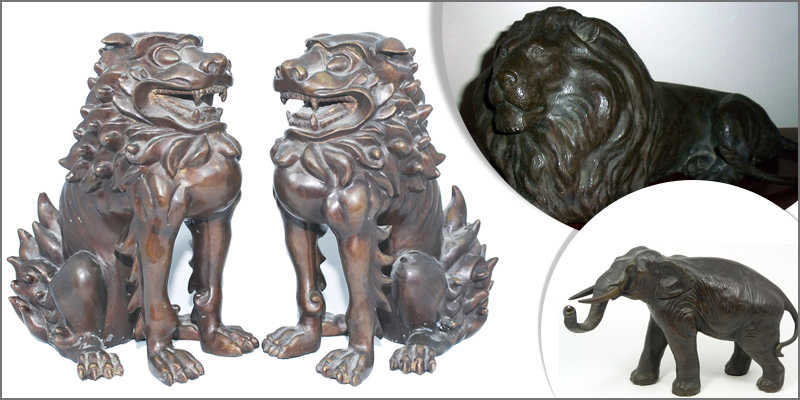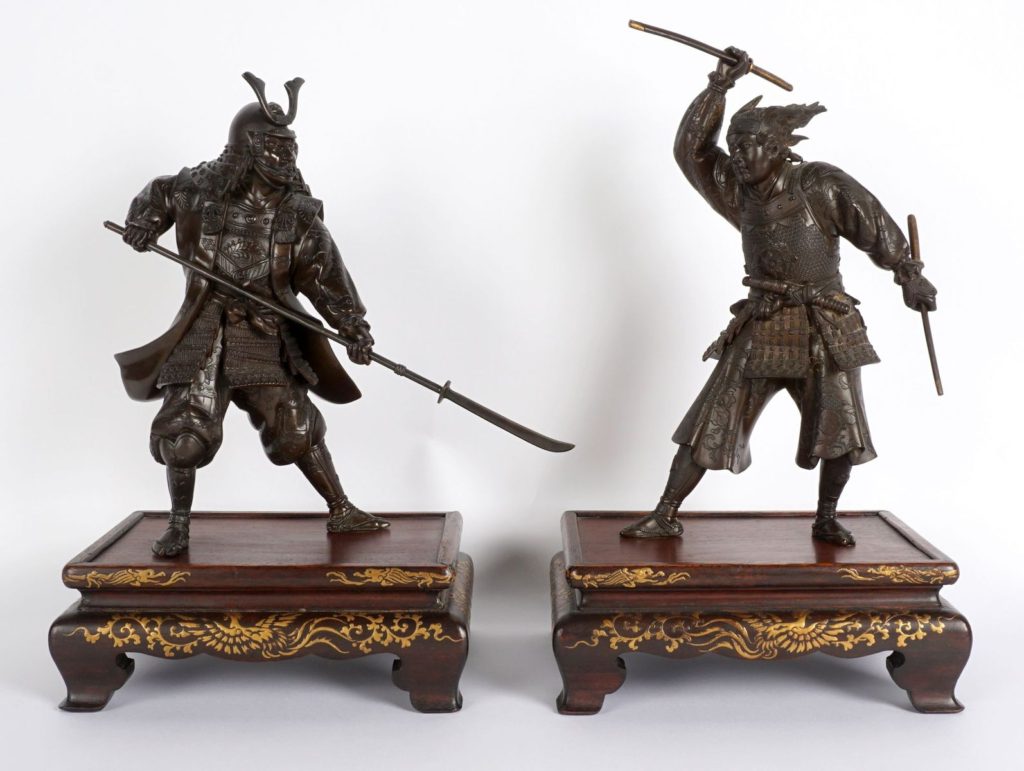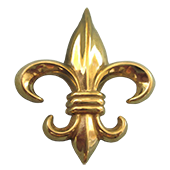Understanding the History of Asian Bronzes
- Posted on 8th January 2024
- in antique appraisal, Antique Art, antique bronzes, antique dealer, Antique Gold and Jewelry, asian bronzes, bronze ancient history
- by Alan
In the Bronze Age, people learned how to mine and smelt copper and tin to make bronze weapons and tools. These weapons and tools were necessary in the Bronze Age when people were learning how to farm and produce high volumes of food that could feed workers such as miners, potters, weavers, builders, and bronze-smiths. Diving into the history of the Bronze Age, the Asian bronzes began around 1700 BCE. At the start of the Bronze Age, this Chinese culture was characterized by a strong centralized government, urban communities with stratified social classes, palatial architecture, a distinctive system of writing, elaborate religious rituals, sophisticated art forms, and bronze metallurgy.

Asian Bronze Age History
In 1700 BCE, the Shang dynasty’s kingdom spanned the Yellow River banks across northern China. Some Shang kings sometimes ruled more than the northern parts of China. The people who lived during the Bronze Age did not drink tea or eat rice as it is sometimes believed, but instead, they consumed cereals, breads, and cakes and drank beer. The more wealthy members of the Bronze Age would have wine and meat in their diet. During this time, essentially the societal equivalent of Medieval Europe, the Shang kings rode with nobles and knights to hunt and fight wars, doing whatever they could to expand their ruled land.

Beautiful wine cups were created with designs traced back to this time zone and location worldwide to enjoy their wine. The wine cups are one of the earliest known Chinese bronze vessels. Beyond the simple wine cups, there were life-sized terracotta figures. In other cultures, bronze was used for tools and weapons. However, bronze was used in China to craft artifacts that played central roles in rituals and ancestor worship. The ritual artifacts represent the wealth and power of leaders during this time, while the artifacts show the highest degree of technical and artistic accomplishments for early Chinese civilization.
Bronze Age Designs
The designs on the bronzes during this age are unique and exciting. The Shang artists were very interested in their work capturing real and imaginary animal forms. Elephants, rams, birds, dragons, owls, tigers, bulls, snakes, and rhinoceroses are all part of the background for the prominent spiral patterns at this time. The design commonly consists of one animal flowing into the next animal. The designs were also meant to represent the vessel’s owner or the ancestor to whom the artifact was dedicated. During the end of the Bronze Age, the artifacts became more worldly symbols that were more important in celebrations than used during rituals to honor the dead.
To develop the bronze artifacts, designs were first cast in a mold made of sections. Once the artifact’s clay model was designed, a clay layer was added. Once they were all dry, cut into sections, pried off, and fired, the model was shaved down to be the core of the mold, and the sections were assembled around it with a space between the two. The molten bronze was poured between the two layers, and once it cooled, the mold was removed, and the artist would burnish the surface smoothly. The Shang designs and decor are consistently made with symmetry, frontality, and incised ornament, with the most frequently designed decoration being a frontal animal mask. Handles on these historical pieces were sculptural, depicting tigers, dragons, and other beasts in ways that emphasize every curve of the item.
Bronze is an alloy of copper and tin used to make various objects since ancient times. Bronze is durable, corrosion-resistant, and can be cast into complex shapes. These qualities made bronze ideal for producing tools, weapons, and ritual vessels in different Asian cultures.
In this article, we will delve into the rich history of Asian bronzes, focusing on the regions of China, India, and Southeast Asia. We will explore the methods of bronze production, its usage, and its value in these areas. Additionally, we will analyze how bronze artifacts reflect their respective civilizations’ artistic, religious, and social aspects.
China: The Cradle of Bronze Civilization
China is widely regarded as the cradle of bronze civilization, boasting the longest and most continuous tradition of bronze casting worldwide. Chinese bronzes date to around 2000 BCE and peaked during the Shang (c. 1600-1046 BCE) and Zhou (c. 1046-256 BCE) dynasties. These periods are also known as the Bronze Age in China, as bronze was the dominant material for making weapons, tools, and ritual vessels.
The ritual vessels, or qi, were Chinese bronze culture’s most distinctive and sophisticated products. They were used for offering food and wine to the ancestors, who were believed to influence the fate of the living. The vessels were often inscribed with the owners’ names, the rituals’ occasions, and the worshippers’ prayers or wishes. The vessels were also decorated with elaborate patterns and motifs, such as animal heads, masks, dragons, and geometric designs.
The ritual vessels of ancient China represent the most remarkable achievement in the whole history of metalcraft before modern times. They demonstrate the high technical skill, artistic creativity, and cultural sophistication of the Chinese bronze casters and their patrons. The vessels also provide valuable insights into ancient Chinese society’s beliefs, values, and history.
India: The Land of Bronze Icons
India has a rich and diverse history of bronze art, spanning from the Indus Valley civilization (c. 2500-1900 BCE) to the present day. Bronze was used for making various objects, such as tools, weapons, coins, and ornaments. However, the most prominent and enduring use of bronze in India was for making religious icons.
The bronze icons, or murti, were images of gods, goddesses, and other sacred figures worshipped in temples, shrines, and homes. The lost-wax casting method made the icons, which involved creating a wax model of the figure, covering it with clay, and then melting the wax out and pouring molten bronze into the mold. This method allowed the bronze casters to produce intricate and realistic details, such as facial expressions, gestures, and ornaments.
The bronze icons of India reflect the diversity and richness of the religious traditions of the subcontinent, such as Hinduism, Buddhism, Jainism, and Sikhism. The icons also embody the aesthetic and spiritual ideals of Indian art and culture, such as beauty, grace, harmony, and devotion. The icons are objects of worship and works of art that inspire and delight the viewers.
Southeast Asia: The Region of Bronze Drums
Southeast Asia is a region that encompasses various countries and cultures, such as Thailand, Cambodia, Vietnam, Indonesia, and the Philippines. Bronze was introduced to this region around 500 BCE and was used for making various objects, such as tools, weapons, jewelry, and bells. However, making drums was the most distinctive and unique use of bronze in Southeast Asia.
The bronze drums, or dong son, were large and heavy instruments used for various purposes, such as communication, music, ceremony, and warfare. The drums were decorated with elaborate designs and scenes, such as animals, plants, people, boats, and houses. The drums were also symbols of power and prestige, as the elites and rulers of the society owned them.
The bronze drums of Southeast Asia reflect the cultural and historical diversity and complexity of the region. The drums show the influences and interactions of different civilizations, such as China, India, and the local indigenous groups. The drums also reveal the region’s social and political dynamics and changes, such as the rise and fall of kingdoms, the spread of religions, and the impact of colonialism.
Conclusion
Asian bronzes are fascinating and valuable artifacts that tell us about the history, culture, and art of Asia’s different regions and civilizations. Bronze was a versatile and durable material used for making various objects. However, the most remarkable and distinctive products of bronze culture were the ritual vessels of China, the icons of India, and the drums of Southeast Asia. These objects demonstrate the technical skill, artistic creativity, and cultural sophistication of the Asian bronze casters and their patrons. They also provide valuable insights into the beliefs, values, and history of Asian society.
Over time, these ancient bronzes were preserved in many different ways. Some were buried in storage pits and expertly hidden; some were even included in burial tombs. Royal families in the Shang dynasty would be accompanied in the afterlife by their bronzes, ceramics, weapons, amulets, and ornaments. If you have one of these rare and unique pieces that may be an Asian bronze, bring your item to Sarasota Antique Buyers. We buy vessels, figures, buds, imperial pieces, and markings and would be happy to tell you the value of the item that you have. We travel to St Pete, Port Charlotte, Naples, and Orlando weekly. Please call us to schedule an appointment or fill out one of our contact forms with photos.
